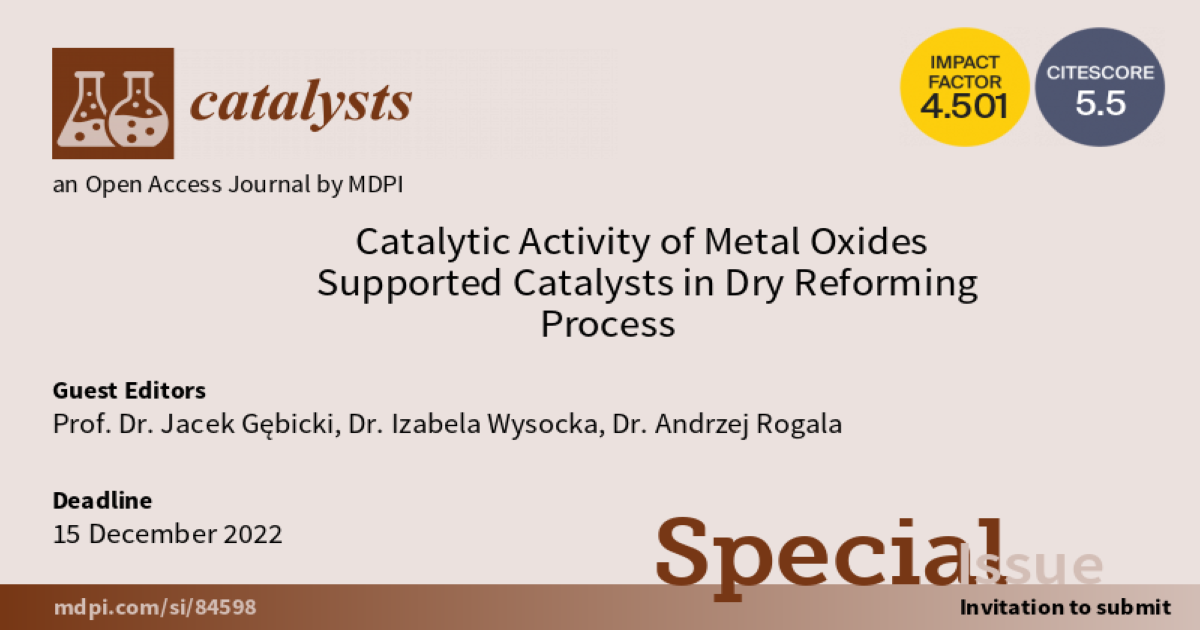Catalytic Activity of Metal Oxides Supported Catalysts in Dry Reforming Process
A special issue of Catalysts (ISSN 2073-4344). This special issue belongs to the section "Catalytic Materials".
Deadline for manuscript submissions: closed (15 December 2022) | Viewed by 20332

Special Issue Editors
Interests: monitoring of air pollution; biogas purification; air pollution control systems; biofiltration; ionic liquids; low-cost air pollution monitoring systems; green deodorization methods
Special Issues, Collections and Topics in MDPI journals
Interests: catalysis; nanoparticles; metal carbides; 2D materials; 2D Xenes; photocatalysis; dry reforming; steam reforming; dimethyl ether synthesis; catalysts
Interests: catalysis; nanoparticles; dry reforming; steam reforming; dimethyl ether synthesis; catalysts; process intensification; heat transfer
Special Issue Information
Dear Colleagues,
Nowadays, carbon dioxide is one of the most significant greenhouse gases. The worldwide accepted sustainable development goals strongly express the need to reduce greenhouse gas emissions. Nevertheless, the current shape of the chemical industry indicates the commitment to processes that lead to emissions of carbon oxides. The most environmentally friendly way of waste management is reuse as a raw material. Among the methods of CO2 reuse, dry reforming (DR) seems to be a very promising technique due to the possibility of synthesising gas with the required products’ molar ratio in the output stream.
Dry reforming takes place in the presence of catalysts. Commercially used catalysts are based on nickel particles due to their high activity and its relatively low price. However, DR reaction conditions favour sintering of the active particles and coking of the catalyst. The size, shape and composition of catalytic materials are crucial factors determining the activity and stability. Therefore, developing new catalysts with a high activity and catalytic stability is undoubtedly still a scientific challenge and of special interest.
The Special Issue will gather research articles and short reviews related to the dry reforming of carbon and hydrogen-containing molecules (e.g., hydrocarbons, diols, alcohols, plastics), including developing new catalysts for DR of desired morphology, investigation of process parameters, investigation of catalysts’ synthesis routes and studies on the stability of materials in under DR conditions. Computational studies on catalysts within the above scope are also welcome.
Prof. Dr. Jacek Gębicki
Dr. Izabela Wysocka
Dr. Andrzej Rogala
Guest Editors
Manuscript Submission Information
Manuscripts should be submitted online at www.mdpi.com by registering and logging in to this website. Once you are registered, click here to go to the submission form. Manuscripts can be submitted until the deadline. All submissions that pass pre-check are peer-reviewed. Accepted papers will be published continuously in the journal (as soon as accepted) and will be listed together on the special issue website. Research articles, review articles as well as short communications are invited. For planned papers, a title and short abstract (about 100 words) can be sent to the Editorial Office for announcement on this website.
Submitted manuscripts should not have been published previously, nor be under consideration for publication elsewhere (except conference proceedings papers). All manuscripts are thoroughly refereed through a single-blind peer-review process. A guide for authors and other relevant information for submission of manuscripts is available on the Instructions for Authors page. Catalysts is an international peer-reviewed open access monthly journal published by MDPI.
Please visit the Instructions for Authors page before submitting a manuscript. The Article Processing Charge (APC) for publication in this open access journal is 2200 CHF (Swiss Francs). Submitted papers should be well formatted and use good English. Authors may use MDPI's English editing service prior to publication or during author revisions.
Keywords
- Catalytic materials
- dry reforming
- carbon dioxide
- nanoparticles
- metal-support interactions
- nickel catalysts
- hydrocarbons
- synthetic gas
Benefits of Publishing in a Special Issue
- Ease of navigation: Grouping papers by topic helps scholars navigate broad scope journals more efficiently.
- Greater discoverability: Special Issues support the reach and impact of scientific research. Articles in Special Issues are more discoverable and cited more frequently.
- Expansion of research network: Special Issues facilitate connections among authors, fostering scientific collaborations.
- External promotion: Articles in Special Issues are often promoted through the journal's social media, increasing their visibility.
- Reprint: MDPI Books provides the opportunity to republish successful Special Issues in book format, both online and in print.
Further information on MDPI's Special Issue policies can be found here.







